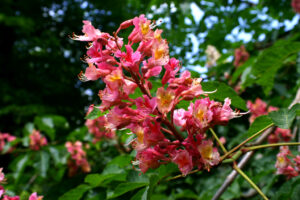 I have always loved plants, especially those with showy flowers, but I did not learn to really see flowers until I took a couple of courses in botanical illustration. During my study of that ancient art, I discovered—first and foremost–that I will never be a great artist. That was a bit disappointing, as from time to time, I have longed to be like Maria Sybilla Merrian, the great seventeenth and early eighteenth century German artist and naturalist. Merrian, defying most of the conventions of her time, traveled to far-off places like Suriname to study and paint from life. Her paintings were full of color and animation, revealing the mysteries of plants and—significantly—insects that would have been new and exotic to her audience. Her work furthered the causes of both art and science.
I have always loved plants, especially those with showy flowers, but I did not learn to really see flowers until I took a couple of courses in botanical illustration. During my study of that ancient art, I discovered—first and foremost–that I will never be a great artist. That was a bit disappointing, as from time to time, I have longed to be like Maria Sybilla Merrian, the great seventeenth and early eighteenth century German artist and naturalist. Merrian, defying most of the conventions of her time, traveled to far-off places like Suriname to study and paint from life. Her paintings were full of color and animation, revealing the mysteries of plants and—significantly—insects that would have been new and exotic to her audience. Her work furthered the causes of both art and science.
After recovering from that disappointment, I made my own discoveries, and found that the process of trying to depict flowers and other plant parts in watercolors opened my eyes—literally and figuratively—to shape, form and color. My horizons widened from the specimens in my own garden to those of my neighbors. My gaze gradually moved upward from ground level to the sky.
And that is when I fell in love with Aesculus x carnea or the red horse chestnut or buckeye tree.
Most of us are familiar with the common horse chestnut, known botanically as Aesculus hippocastanum. The trees grow tall—sometimes as big as 75 feet in height, with a width of 40 to 70 feet. The big palmate or handlike leaves are made up of seven individual leaflets, each of which can be up to 10 inches long. In mid-spring, the trees erupt with huge candles or showy, upright flower panicles that woody plant expert Michael Dirr describes as “perfect” with white flowers blotched at the bases with yellow blushing to pink.. Inevitably, the petals fade and fall, giving way to glossy brown, buckeyed fruits protected by prickly green covers that age to brown before splitting to release the nuts inside. I used to collect horse chestnuts as a child, keeping only the biggest and glossiest specimens.
Common horse chestnuts are still around, but in many neighborhoods they have fallen from favor because the trunks and root zones are too big to fit comfortably into the strip between the sidewalk and the street. The trees also produce the dreaded “litter” that suburbanites hate, showering the sidewalk with spent petals in spring and chestnut fruits and casings in the fall.
Aesculus x carnea is a more common street side sight these days, because it is somewhat smaller than its common horse chestnut relative, growing only 25 to 35 feet tall and wide. The compound leaves are glossy green, with the typical horse chestnut configuration. What distinguishes this smaller tree is its flowery “candles”, which are often described as “red”, but are actually a dark rose-pink. They are magnificent, even if viewed from a speeding car, and cover the trees just slightly later than the pale “candles” of the common horse chestnut.
Aesculus x carnea is a hybrid, but did not result from the breeders’ art. It was discovered in 1812, as war between Great Britain and the nascent United States was raging. The parents of the rosy-flowered tree were determined to be the common horse chestnut, a European native, and another species, the American native Aesculus pavia or red buckeye. Both parents contributed palmate leaves, while the red buckeye added pink to red flowers. The carnea hybrid splits the height differential between its parents. It is shorter than the common horse chestnut and taller than the shrubbier red buckeye.
The most common commercially available red horse chestnut is the ‘Briotii’ variety, named in honor of a nineteenth century French botanist, Pierre Louis Briot. Supposedly ‘Briotii’ features a deeper red color than the hybrid, and is therefore even more dramatic in the landscape.
“Red” in gardening is often a relative term. Most red horse chestnuts are still dark pink.
If you want to try a red horse chestnut in your landscape, make sure your site has consistent moisture. Very light shade is a good idea, though I have seen red horse chestnut street trees that do just fine in full sun. It is most likely that the farther south you live in North America, the more you need to provide a bit of shade and a lot of moisture, especially for a young tree. Too much sun can result in leaf scorch.
Like the parent chestnuts, the red horse chestnut produces “litter” in the form of green capsules that usually contain several small, bitter fruits. The fruits are poisonous if ingested. In this era of ubiquitous leaf blowers, the whole mess can be easily removed.
Find red horse chestnuts in local nurseries, especially at this time of year. You can also order one from Forestfarm, 14643 Watergap Rd, Williams, OR 97544; Tel. (541) 846-7269; www.forestfarm.com. Print catalog available.
